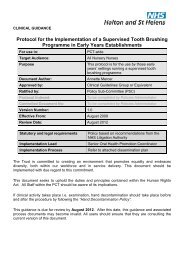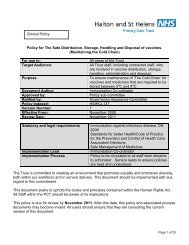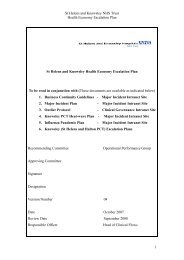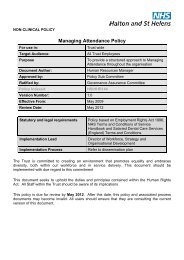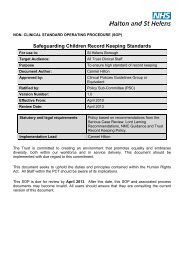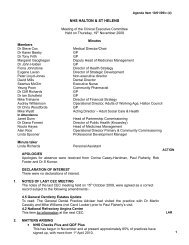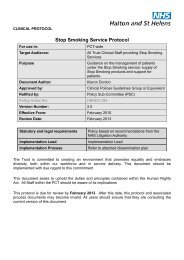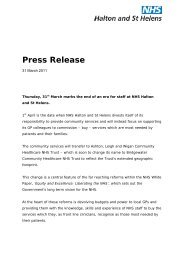Collaborative Intravenous Nursing Service (CINS) Guidelines
Collaborative Intravenous Nursing Service (CINS) Guidelines
Collaborative Intravenous Nursing Service (CINS) Guidelines
- No tags were found...
Create successful ePaper yourself
Turn your PDF publications into a flip-book with our unique Google optimized e-Paper software.
Ensure all equipment is gathered before commencing the procedure and all packagingis intact and in date.• Open sterile pack allowing inner pack to fall onto clean working area.• Open out sterile pack to create a sterile field. Open remaining equipment ensuring nocontamination of sterile field.• Place 0.9% sodium Chloride (saline) & Heparinised Saline ampoules near to theworking area but not on the sterile field. Pour out alcohol Chlorhexidine solution.• Ensure easy access to the needle free system.• Decontaminate hands.• Put on sterile gloves.• Connect needle/ filter straw to the syringe.• With a piece of sterile gauze pick up the Sodium Chloride 0.9% (saline) ampoule, drawup 10ml of solution. Repeat for Heparinised Saline. If used, dispose of the needledirectly into sharps container, place the filled syringes on the sterile field.• Place sterile towel as near as possible to the catheter• Using a piece of sterile gauze soaked in alcohol Chlorhexidine solution, scrub the topthen the sides of the needle free system connection and allow to dry.• Alternatively, scrub the hub of the needle free system with 2% Chlorhexidineimpregnated wipe, rubbing from the top of the needle free connector to the sides. Dothis three times using different parts of the wipe over a period of 30 seconds. Allow todry.• Attach syringe with 0.9% Sodium Chloride flush and inject the flush using apush/pause action, clamping as the last ml of solution is instilled into the catheter.• Remove the syringe and discard. If open ended skin tunnelled catheter repeat thisprocedure using syringe containing Heparin 10units/ml in 0.9% Sodium Chloride.• For Patients’ in the community discharged from Christie Hospital, Attach empty 10mlsyringe into needle free system and aspirate at least 10ml of blood from the catheterand discard. If unable to do so refer to The Christie management of problems relatedto central venous catheters in the community.• NEVER FORCE THE SOLUTION INTO THE CATHETER, this can damage thecatheter.• Ensure that the catheter is secure and comfortable.To maintain a sterile field.Chlorhexidine-based solutions arerecommended (in alcohol) as per policy(DOH 2001).10ml syringes should always be used;smaller syringe sizes may damage thecatheter (Hadaway 1998).There is no requirement to routinelywithdraw blood and discard it prior toflushing (except prior to blood samplingalthough the first sample can be used forblood cultures (RCN 2005).There is an increased risk of infection andocclusion when withdrawing blood via acentral venous catheter (RCN 2005),therefore for routine flushing of a linewithdrawal of blood is not required.The pulsated flush creates turbulencewithin the catheter lumen, removingdebris from the internal catheter wall(Goodwin & Carlson 1993, Todd 1998).Positive pressure within the lumen of thecatheter should be maintained to preventreflux of blood (INS 2000).9The CINs group hereby assert their moral rights tothe works herein in accordance with the Data Protection Act 1988.Policy review date 01/10/10




